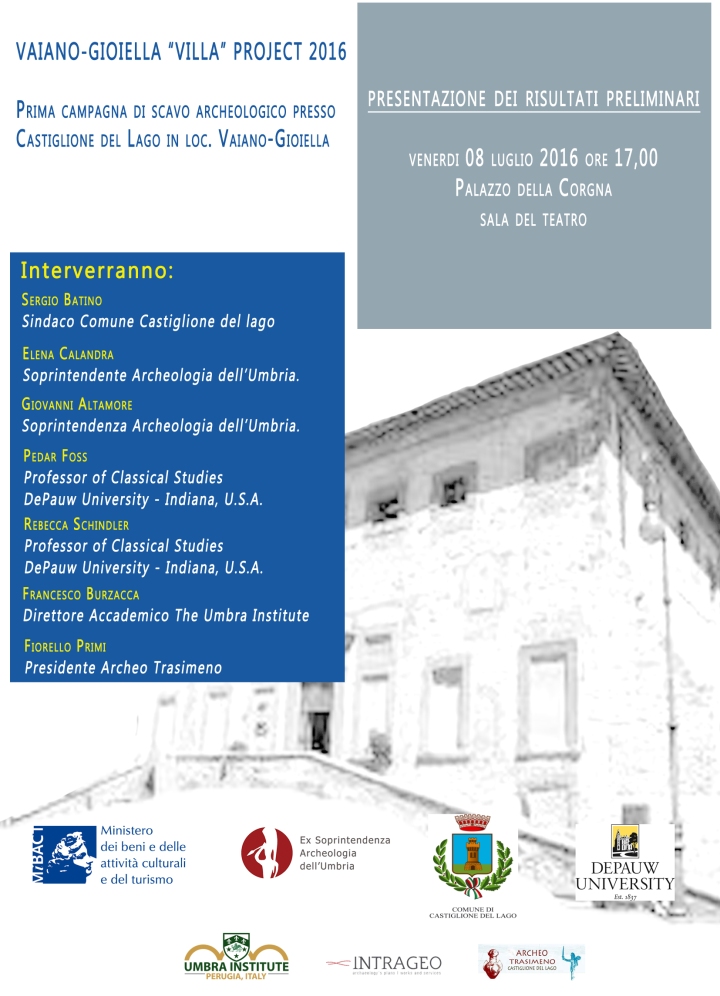
[English]
8 July 2016
Castiglione del Lago—The Umbra Institute-DePauw University Archaeological Project in the Comune of Castiglione del Lago has completed the first season of excavation at the Vaiano-Gioiella ‘Villa’ site. Authorized by the Ministero dei Beni Culturali and the Soprintendenza Archeologica dell’Umbria, the archaeological project is a collaboration between The Umbra Institute (Perugia), DePauw University (Indiana, USA), and Intrageo. The excavations were conducted with the support of the Comune of Castiglione del Lago and the Archeo Trasimeno group. The excavation directors are Giampiero Bevagna (Umbra Institute), Pedar Foss (DePauw University), Rebecca Schindler (DePauw University), and Stefano Spiganti (Intrageo).
The archaeological site “La Villa” is located on a hill to the north of Lago di Chiusi. To the east of the site there is also an ancient road and a cistern for collecting water, both of which probably date to the Roman period. A surface survey of the Vaiano-Gioiella Villa site conducted in 2015 revealed that the site was occupied, but perhaps not continuously, from the 2nd century B.C. to the 3rd century A.D. The distribution of material recovered from the surface in 2015 also suggested that this was a large complex with at least two distinct building areas: one to the south, where fragments belonging to a thermal structure were recovered, and another to the north.
The 2016 excavation season began on 6 June. Due to the intense rain at the beginning of the month, the excavations were interrupted for over a week. In the end, the excavation team was able to work in the field for approximately 15 days. During that time four squares were excavated. Based on the survey information from 2015, the project began excavation on the eastern edge of the site. Two distinct areas of debris accumulated sue to subsequent activity on the site were uncovered as well as a collapse from a building that included roof tiles and part of a cocciopesto – over 153 kg of tile within an area of 1×4 meters. The most interesting discovery this season is a channel that was cut into the natural sediment and then covered with tiles pitched to form a triangular covering. This appears to be a drainage system, even though it does not have a bottom that would allow water to flow but was constructed directly on the natural sediment. The channel is at least 6.5 meters long but its overall length remains to be discovered.
The materials from the excavation confirm that there was a thermal complex on the site as there are examples of tiles for heating a floor, tubuli for heating the walls, and mosaic fragments. The excavations also uncovered several examples of Sigillata Italica (Aretina) with stamps from the manufacturers. Moreover, the recovery of numerous artifacts with traces of burning indicates that ceramics and possibly metals were produced at the villa complex.
________________________________________________________________
[Italiano]
8 luglio 2016
Castiglione del Lago — La ricerca archeologica condotta da The Umbra Institute-DePauw University nel Comune di Castiglione del Lago ha completato la prima campagna di scavi al sito della ‘Villa’ di Vaiano-Gioiella. Autorizzata dal Ministero dei Beni Culturali e dalla Soprintendenza Archeologica dell’Umbria, la ricerca è il risultato della collaborazione tra The Umbra Institute (Perugia), DePauw University (Indiana, Usa) e Intrageo. Gli scavi sono stati condotti con il supporto del Comune di Castiglione del Lago e del gruppo Archeo Trasimeno. I direttori dello scavo sono Giampiero Bevagna (The Umbra Institute), Pedar Foss (DePauw University), Rebecca Schindler (DePauw University) e Stefano Spiganti (Intrageo).
Il sito archeologico “La Villa” è situato su una collina a nord del Lago di Chiusi. Ad est di quest’ultimo sono presenti una strada ed una cisterna di raccolta delle acque, entrambi probabilmente di epoca romana. Una prima ricognizione intensiva della superficie della Villa di Vaiano-Gioiella, condotta nel 2015, ha rilevato che il sito fu occupato, anche se forse non in modo continuativo, dal II secolo a.C al III secolo d.C. Anche la distribuzione dei materiali trovati in superficie suggerisce che l’insediamento era un complesso di notevoli dimensioni con almeno due strutture distinte: una a sud, dove sono stati rinvenuti materiali pertinenti ad un impianto termale, e una a nord.
La campagna di scavi del 2016 ha avuto inizio il 6 giugno. A causa delle pioggie persistenti dei primi di giorni del mese, lo scavo, è stato interrotto per oltre una settimana. In totale, l’équipe di lavoro ha potuto svolgere le indagini al sito per circa 15 giorni. Durante questo periodo, sono stati scavati quattro quadrati. Sulla base delle informazioni raccolte durante la ricognizione del 2015, le ricerche sono iniziate nella parte orientale del sito. Sono state rinvenute due distinte aree di accumulo di materiale dovuto probabilmente ad una sistemazione successiva dell’area, insieme a un crollo della struttura del tetto di un edificio, composto da tegole e coppi, insieme a porzioni di pavimento in cocciopesto – oltre 153kg di tegole in un’area di 1×4 metri. La scoperta più interessante di questa campagna è una canaletta inserita nel sedimento naturale e coperta con tegole poste in modo tale da formare un triangolo. Sembra essere un sistema di drenaggio, sebbene non sia provvista di un fondo di scorrimento, ma sia collocata direttamente sul sedimento naturale. La canaletta è lunga almeno 6.5 metri, ma la sua lunghezza totale resta ancora da scoprire.
I materiali trovati nello scavo confermano l’esistenza di un complesso termale nel sito, poiché sono stati recuperati esempi di tegole pertinenti al riscaldamento del pavimento, tubuli per il riscalmento delle pareti e frammenti di mosaici. Gli scavi hanno portato alla luce anche diversi esempi di Sigillata Italica (Aretina) con bolli di fabbrica. Inoltre, il ritrovamento di numerosi materiali con tracce di incendio indicano che la ceramica e forse anche i metalli venivano prodotti nel complesso della villa.